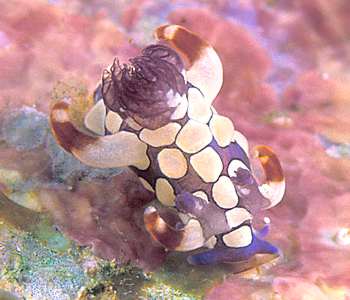
Trapania scurra
Gosliner & Fahey, 2008
Order: NUDIBRANCHIA
Suborder: DORIDINA
Superfamily: ANADORIDOIDEA
Family: Goniodorididae
DISTRIBUTION
Known from the Phillippines, Malaysia and Indonesia.
PHOTO
Upper right: Anilao, Luzon Island, Philippines. Depth: 40 feet. Length: 5 mm. April, 2004. Photographer: Jeff Rosenfeld. Lower left: CASIZ 103787. Radular morphology. Scale= 20 µm. Lower right: CASIZ 103787, Philippine Islands, 15 mm. Photo: T. Gosliner.
The background colour of the body is a translucent purple or lavender, deepening to an opaque blue on the head and posterior tip of the body/ foot. There are larger white rounded patches scattered in what appears to be a regular and symmetrical pattern on the body. There are 5 along the midline between the front of the head and the gills and three behind the gills. There are two on each side of the large patch just in front of the gills, and another one just behind each rhinophore. There are 2 or 3 along each side of the body and these appear to be slightly raised. Each white patch is edged with a thin dark - probably blue - line. The extra-branchial and extra-rhinophoral processes are opaque white with two translucent blusih or brownish bands and the gills and rhinophores are translucent clear with darker bluish-purple edging.
The living animal grows to at least 15 mm in length.
This species was known previously on the Forum as Trapania sp. 6.
-
Gosliner, T.M. & Fahey, S.H. (2008) Systematics of Trapania (Mollusca: Nudibranchia: Goniodorididae) with descriptions of 16 new species Systematics and Biodiversity, 6 (1): 53-98
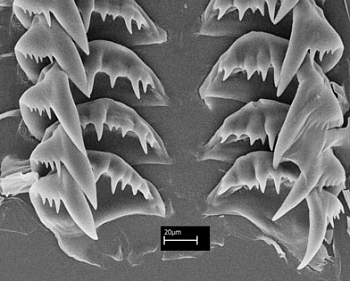
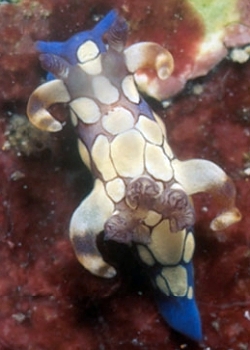
Rudman, W.B., 2008 (March 10) Trapania scurra Gosliner & Fahey, 2008. [In] Sea Slug Forum. Australian Museum, Sydney. Available from http://www.seaslugforum.net/find/trapscur
Related messages
Re: Trapania scurra from Japan
September 21, 2009
From: Ayumi Murakami
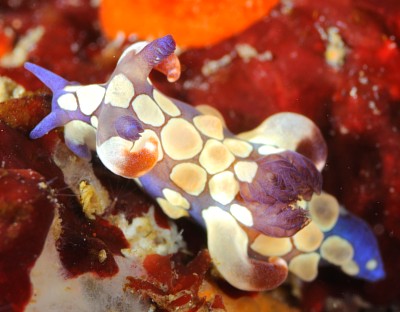
Concerning message #14652:
Dear Bill
I hope you are well and enjoying the weather in Sydney.
I observed something that I belived was a Trapania scurra on September 12th in Futou, Izu Peninsula, Japan.
Locality: Futou beach, 10 m, Izu Peninsula, Japan, Pacific Ocean, 12 September 2009, rock wall. Length: 8-12 mm. Photographer: Ayumi Murakami.
It was in a cavity on a rock wall. The length of this slug was about 12 mm with its body fully extended.
It looked like it was feeding because there was white substance it was crawling around which appeared to be Entoprocts or Kamptozoa that you mentioned on your report from Takako Uno [message #8262].
Any comments you can provide would be greatly appreciated.
Best regards
Ayumi Murakami
umiushi10@masea.info
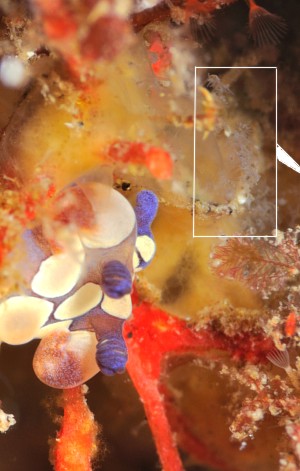
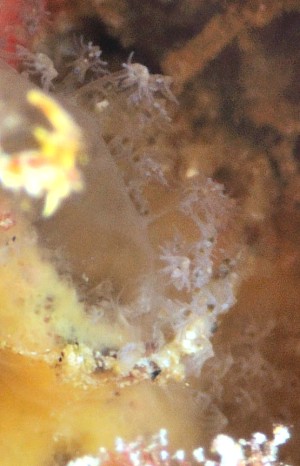
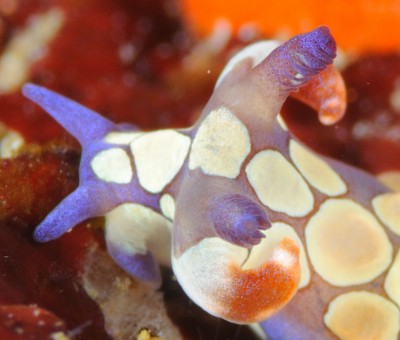
Dear Ayumi,
Yes this is T. scurra. As far as I know this is the first record of the species from Japan, so that is a nice find. I have included a close-up of the 'white substance' you thought might be the food of this species. It is indeed a colony of kamptozoa, which certainly suggests they are the food of this species.
Best wishes,
Bill Rudman
Trapania sp. 6 from Philippines
August 31, 2005
From: Jeff Rosenfeld
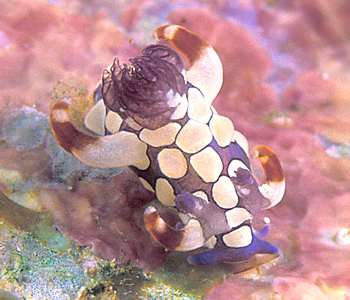
Note added 12 March 2008: This species has been named Trapania scurra
Hi Bill,
Here's a shot of what appears to be what you're calling Trapania sp. 6. It was taken in Anilao, Luzon Island, Philippines in April, 2004.
Locality: Anilao, Luzon Island, Philippines. Depth: 40 feet. Length: 5 mm. April, 2004. Photographer: Jeff Rosenfeld
Thanks,
Jeff
jeff@rosenfeldfamily.net
Rosenfeld, Jeff, 2005 (Aug 31) Trapania sp. 6 from Philippines. [Message in] Sea Slug Forum. Australian Museum, Sydney. Available from http://www.seaslugforum.net/find/14658Dear Jeff,
By coincidence your message arrived just as I was preparing Cor Bosman's message [#14652] about the same species from Indonesia. It is surely one of the most distinctively coloured species of the genus.
Best wishes,
Bill Rudman
Unknown nudibranch from Sulawesi
August 31, 2005
From: Cor Bosman
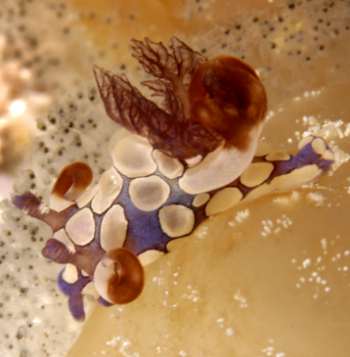
Note added 12 March 2008: This species has been named Trapania scurra
Hi,
I found this nudibranch during a night dive at Wakatobi, South East Sulawesi, on August 28 2005.
Locality: Wakatobi Resort, Tomia Island Group, South East Sulawesi, Banda Sea. Indonesia. Depth: 60 feet. Length: 1 inch. 28 August 2005. Rubble, Coral Heads. Photographer: Cor Bosman
The area is a sandy/rubble bottom with coral heads. This nudibranch was located at the bottom of one of the coral heads, a few inches from the sand. It was on top of a tunicate. On the tunicate were some eggs. It was unclear if the nudibranch was eating the eggs or tunicate, or just passing by (see photo). None of the dive guides had ever seen this nudibranch, or even anything similar. I can't find it in any of the books.
Can you help identify it?
Thanks!
Regards,
Cor Bosman
cor@xs4all.nl
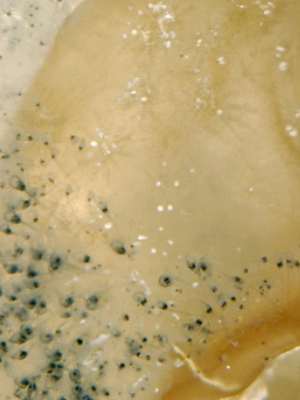
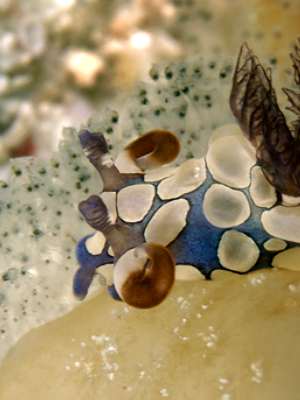
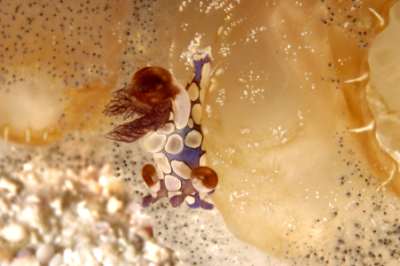
Dear Cor,
This is a very interesting find. It is an unnamed species of Trapania which is on the Forum as Trapania sp 6. What is particularly exciting is that in Takako Uno's earlier message [#8262] he reports it crawling on a white ascidian and eating bryozoans living on the ascidian. The 'bryozoans' are in fact a species of the small phylum Kamptozoa [= Entoprocta] which we know from many examples on the Forum is the food of most species of Trapania. The 'eggs' you mention are in fact a dense colony of these kamptozoa. I have added a couple of elargements of your photo to show the kamptozoans in more detail. You will see they have a long stalk and a cup-shaped body with a black sphere at the base of the cup. In the photo alongside it looks like the Trapania as eaten the kamptozoa off a section od the ascidian in the foreground. Although a statistician wouldn't like the sample size, it looks like this species of Trapania has an association with a species of kamptozoa which lives on an ascidian. Very interesting!
Best wishes,
Bill Rudman
Trapania sp. 6 from Borneo
April 25, 2003
From: Robert Borzymek
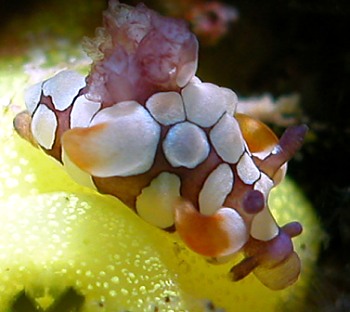
Note added 12 March 2008: This species has been named Trapania scurra
Hi,
I have took this picture in March 2003 in Kapalai, Borneo on 17 meters. It was about 5mm long. I cannot find its name. Has anyone seen it before somewhere else?
Best regards
Robert Borzymek
r.borzymek@millenniumdivers.mcnet.pl
Borzymek, R., 2003 (Apr 25) Trapania sp. 6 from Borneo. [Message in] Sea Slug Forum. Australian Museum, Sydney. Available from http://www.seaslugforum.net/find/9736Dear Robert,
This is an unnamed species of Trapania which I am calling Trapania sp. 6 on the Forum. From the way its mouth seems to be extended it looks like its food is nearby. Have a look at Takako Uno's message for some photos and discussion on its probable food.
Best wishes,
Bill Rudman
Is this a new species of Trapania?
October 28, 2002
From: Takako Uno
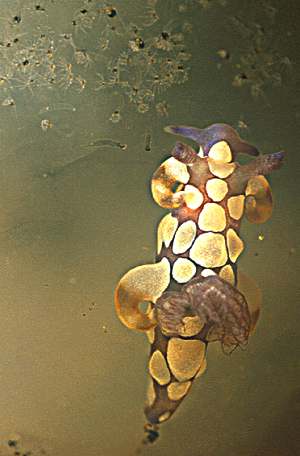
Note added 12 March 2008: This species has been named Trapania scurra
Dear Dr. Rudman,
I am attaching a few images of a Nudibranch (I believe it may be a Trapania) that I recently photographed in Bali, Indonesia. I cannot find this species in my library of books. I have contacted a Japanese specialist, Dr. Yoshi Hirano, and he has asked me to contact you, since he does not know this nudibranch. Please kindly identify for me, when you have the time. Much appreciated for your generous help.
Some more information:
The images were shot on August 28th 2002;
The depth of water was 10 meter;
Water temperature was 28 degrees Celsius;
Nudibranch size was 3-5mm (with the oral feelers extended);
The Nudibranch was walking on the white-colored tunicates, which have some kind of Bryozoans attached to them. It looked as though the nudibranch was feeding on the bryozoans. I only found a single specimens in the area.
Looking forward to your kind advice.
Warmest wishes,
Takako Uno
divetoto@hotmail.com
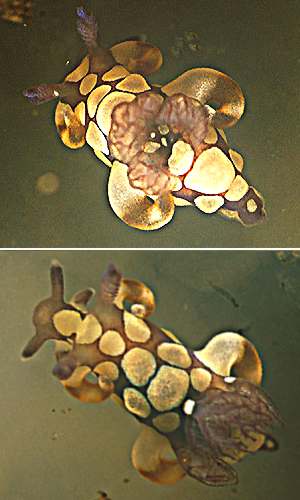
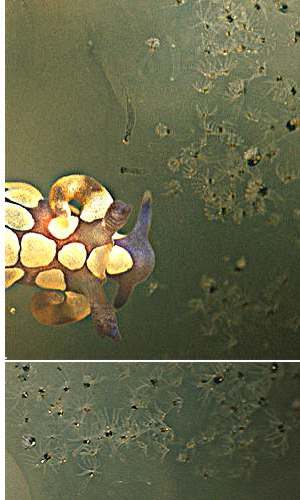
Dear Takako,
Thanks for the photo. This certainly looks like a species of Trapania but it is not a species I recognise so could well be an unnamed species. I am very interested in your observations of its possible food, and I have included a close-up view of the organisms. They are in fact not bryozoans but a distinct phylum of animals which are called Kamptozoa or Entoprocta. They are tint stalked animals with a ring of feeding tentacles around the top of the body, much like a cnidarian polyp. Many species occur in large populations attached to other invertebrates, often on sponges, or in this case on a large tunicate. If you look at the messages on other species of Trapania you will see that we are discovering that all species of Trapania appear to feed on entoprocts (kamptozoa).
Best wishes,
Bill Rudman
